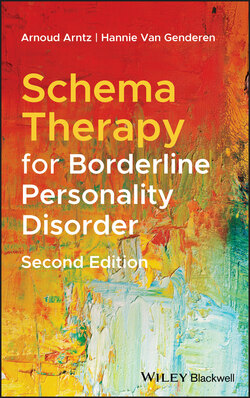Читать книгу Schema Therapy for Borderline Personality Disorder - Hannie van Genderen - Страница 44
Questionnaires
ОглавлениеTo assess the patient's schemas and modes, the Young Schema Questionnaire (YSQ; Young, 1999), the Schema Mode Inventory (SMI; Lobbestael, van Vreeswijk & Arntz, 2008) and other questionnaires are completed by the patient along the first few sessions. The results are discussed with the patient. The Young Parenting Inventory can be helpful in clarifying factors that have influenced the development of the modes. The Borderline Personality Disorder Severity Index (BPDSI) is a structured interview that assesses the seriousness and frequency of BPD symptoms and expressions that meet DSM‐IV criteria and have been experienced within the previous three‐month period (Arntz et al., 2003; Giesen‐Bloo et al., 2006; Giesen‐Bloo, Wachters, Schouten, & Arntz, 2010).
With the help of the BPD checklist the patient can indicate to what extent her BPD symptoms have been a burden to her in the past month (Bloo, Arntz, & Schouten, 2017). The Personality Disorder Beliefs Questionnaire (PDBQ) includes a subscale with statements specifically relating to BPD (Arntz, Dreessen, Schouten, & Weertman, 2004). From the Personality Beliefs Questionnaire (PBQ) a series of items specific to BPD have been derived (Butler, Brown, Beck, & Grisham, 2002).
When the patient has a high score in the YSQ or SMI, you can be sure that this is an important problem. But be aware of the fact that questionnaires can give incomplete or biased information. Because of the personality problems, patients might be unwilling to reveal specific information, might present a too good picture of themselves to be true, or might over‐report problems. Patients might not be aware of specific modes or schemas, they might misinterpret items, or respond in a way they think is desirable. Patients with strong overcompensating modes usually don't report an abandoned/abused child mode (or any vulnerable child mode), which is actually predicted by schema mode theory, as overcompensating modes have the function to make the patient believe that he or she is the opposite (Bamelis, Renner, Heidkamp, & Arntz, 2011). Fortunately, questionnaires are not the only way to gather information about the schemas and modes of the patient. Thus, the therapist is recommended to use all kinds of information in the collaborative formulation of the mode model, including the patient's request for help, her description of current and past problems, current and past relationships, study/work history, her developmental history, file information, including from past treatments, and the patient's behavior during the sessions. A schema or a mode might also appear during experiential techniques such as imagery, or when there is a “decompensation,” when the situational triggers are so strong that they cannot be avoided or overcompensated anymore. If an exceptionally large number of modes (or schemas) is reported by the patient, the therapist should try, in collaboration with the patient, to pick the most important ones, so that the mode model remains surveyable. Another possibility is to combine two modes that have a similar function into one mode. The “abandoned/abused child mode” and the “angry/impulsive child mode” are actually examples of such mergers (see Figure 3.1).
The feedback of the results of the questionnaires can best be integrated in the conversation about the complaints and experiences. By delving into an experience of the patient, the discussion of a schema or mode is more involving. Discussing the schemas must encompass more than just stating the names of the schemas or modes and the scores. Educating the patient on how an activated schema or mode feels, helps the patient to recognize the relevant schema or mode and she experiences that the therapist understands her (ST step by step 1.02 and 6.06).
Figure 3.1 Case conceptualization Nora
